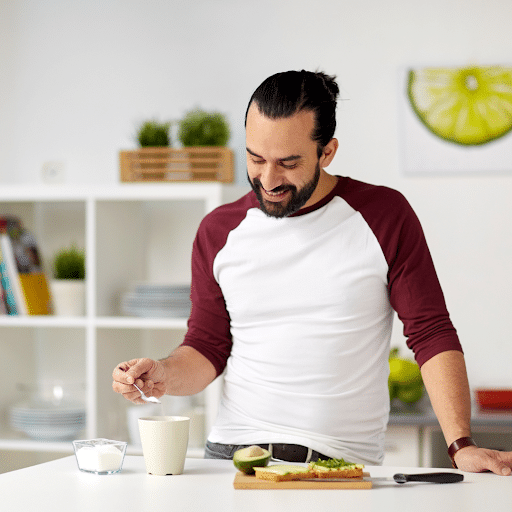What is the difference and why does it matter?
Consider a serving of strawberry yogurt, for example. The label might read 20 grams total sugar and 12 grams added sugar. The 8-gram difference accounts for naturally occurring sugar in the yogurt: natural milk sugar and strawberry pieces. The 12 grams of added sugars are added during manufacturing as cane sugar or another processed sweetener. These sugars do NOT exist naturally in the food and are instead added to enhance flavor and sweetness.
The American Heart Association recommends adults limit their added sugar intake to approximately 30 grams or less per day. However, there is no defined limit for total sugars. This means that we should strive to limit our intake of processed foods with added sugar, but do not need to limit our intake to the same extent for whole foods with natural sugar. Whole foods with natural sugars include fruit, dairy products, and some vegetables like corn and sweet potatoes. There are some “natural” sweeteners like honey, maple syrup, and agave that are less processed than table sugar; however, have similar effects to the body.
Added sugars, when eaten in excess, lead to elevated blood sugars and blood pressure, weight gain, and inflammation. Individuals with diabetes are especially sensitive to these effects and need to take extra caution when consuming high-carbohydrate, high-sugar foods. Many of us have experienced the “blood sugar roller coaster” after eating too many sweet foods at once. We feel a sugar “high” with a sudden burst of energy and endorphins, followed by a “crash” where we feel brain fog and sluggishness.
Although added sugars can be a risk factor for many chronic diseases, it is possible to consume them in moderation and as a result, maintain a healthy relationship with food. Consider these tips for reducing added sugars and finding a balance:
- Replace sugar-sweetened beverages with lower sugar alternatives. Instead of drinking a tall glass of lemonade, try mixing a splash of lemonade into sugar-free sparkling water. Ready to find out the healthiest drinks? Take a look at this short class.
- Make fruit the star of your dessert. Fruit contains natural sugar and a boost of fiber and nutrients, fulfilling your sweet cravings while providing great nutrition. Try fruit with low-sugar yogurt and nuts as a satisfying dessert choice. Take this class to learn about the healthy way to eat fruit.
- Reduce portion sizes of sugary foods, while adding a source of protein and fiber on the side. Struggling to resist those donuts in the break room at work? Enjoy a half while you snack on some carrot sticks and hummus to fill you up.
- Cut added sugars, but don’t cut healthy carbohydrates. Our brain and body run on carbohydrates as their preferred fuel source, so cutting them altogether leaves us feeling even more deprived. Focus on getting enough healthy carbohydrates like fruits, vegetables, beans, and whole grains throughout the day. This will help keep those cravings for processed sugary foods to a minimum. Learn more about Nutrition for Blood Sugar balance here.
- Check your sleep. Research shows we gravitate more toward sweet foods when we are tired and low on sleep, to give us that energy “high”. Make bedtime a priority or give yourself the opportunity to take a nap, which might be what your body really needs.
Managing sugar intake is one of many pieces to our overall health picture of body and mind.
Learn more strategies by enrolling in Burnalong’s platform to view classes on a variety of health topics.
Burnalong (www.Burnalong.com) provides an end-to-end wellness solution focused on helping people achieve their human potential; through a scalable digital platform, social support and motivation, proprietary data and analytics, and AI. People can take classes alone or live with others where they can see and hear each other, and join communities, for added social motivation. Our platform includes access to more than 50,000 live and on-demand classes, taught by 7,500+ instructors, across 70+ categories (spanning physical, emotional, and financial wellness, including programming for chronic conditions, prenatal, children, and disabilities), reflecting the diversity, and diversity of needs, of the population.
Kate Bruckmueller, RDN
Hi there! I am a Registered Dietitian Nutritionist (RDN) with an evidence-based, realistic approach to nutrition. RDNs are recognized as the leading experts in nutrition – we learn the complicated science, so you don’t have to! I believe that healthy eating should NOT feel like a chore, and there is no one-size-fits-all diet. Through my videos, you will learn tips for meal planning and how to personalize your diet so you can sustain progress long-term.







